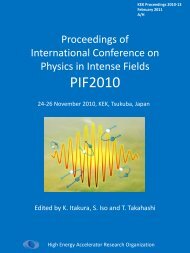TRIAC Progress Report - KEK
TRIAC Progress Report - KEK
TRIAC Progress Report - KEK
Create successful ePaper yourself
Turn your PDF publications into a flip-book with our unique Google optimized e-Paper software.
1. Introduction<br />
Following the successful re-acceleration of short-lived radioactive ion beams<br />
(RIBs) from the isotope separator on-line (ISOL) in the early 1990s, many ISOL-based<br />
RIB facilities have been constructed over the world, and now are operating for various<br />
research fields such as in nuclear physics, nuclear astrophysics, and materials science.<br />
The low-energy RIBs, energy variable and with a high purity and good energy<br />
resolution, are very effective not only for the detailed spectroscopic studies on nuclear<br />
structure using nuclear reactions but also for studies on the structural and dynamical<br />
properties of the bulk of materials.<br />
At the Tandem accelerator facility of JAEA-Tokai, an ISOL-based radioactive ion<br />
beam facility, <strong>TRIAC</strong>-Tokai Radioactive Ion Accelerator Complex - is operational since<br />
the November of 2005. In the facility, short-lived radioactive ions produced by proton<br />
or heavy ion induced nuclear reactions, after being mass-separated by the JAEA-ISOL,<br />
can be accelerated up to the energy necessary for experiments. The energy is variable in<br />
the range from 0.14 to 1.09 MeV/nucleon, which is the energy region available at the<br />
first stage of the complete version of the <strong>TRIAC</strong>.<br />
The present energy range of RIBs available at the <strong>TRIAC</strong> is suitable for direct<br />
measurements for light ion induced nuclear reaction rates involved in the<br />
nucleosynthesis at the explosive stage of the stellar evolution of massive stars as well as<br />
in the early universe. The low energy RIBs can be also incorporated by implantation<br />
into materials of interest whose properties can be probed with an unprecedented<br />
sensitivity by using various nuclear spectroscopy techniques.<br />
Since the first public operation, 50 days per year, in maximum, has been allowed<br />
for experiments, including 10-day operation for the development of the RIB generation<br />
and the acceleration at the <strong>TRIAC</strong>. The experimental proposals were carefully reviewed,<br />
once a year, by the program advisory committee (PAC).<br />
In the following, we first introduce the scientific activities for the developments of<br />
RIB at the <strong>TRIAC</strong>. The summary of the experiments performed so far will follow.<br />
2. Developments of the beam generation and acceleration at the <strong>TRIAC</strong><br />
The developments have been concentrated for the production and acceleration of<br />
heavy (medium-mass) neutron-rich radioactive ion beams with high efficiency. The<br />
followings are included in this section; (1) the development of target / ion source of the<br />
JAEA-ISOL for effective production and ionization of uranium fission fragments, (2)<br />
the development for charge breeding the singly charged ions from the ISOL, (3) the<br />
development of post-accelerators for CW operation, upgrading acceleration energy, and<br />
1













